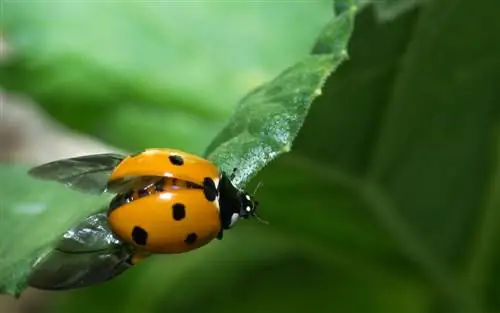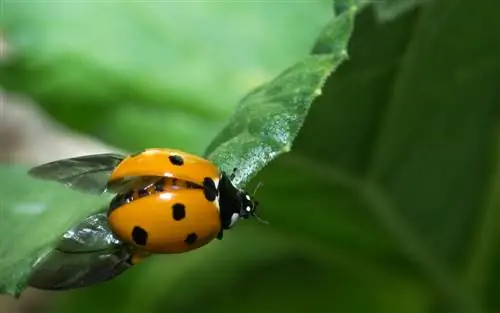- Author admin [email protected].
- Public 2023-12-16 16:46.
- Last modified 2025-01-23 11:22.
Ladybirds are welcome by everyone - especially by knowledgeable hobby gardeners who know about their valuable usefulness. However, not everyone is actively aware of how diverse the ladybird family actually is. Here we present some of them to you.

Which ladybird species are found in Germany?
Common ladybird species such as the seven-spot, ten-spot, Asian and twenty-two-spot ladybirds can be found in Germany. They vary in color, pattern and number of dots, and are useful assistants in the garden for combating aphids and mildew fungi.
The amazing diversity of ladybirds
Ladybirds form their own family within the zoological order of beetles. And it is extremely diverse. In this country you are hardly aware of this because we only have a fraction of the many different species. In addition, most people associate ladybugs with the typical black dot coloration on a red background. There are also species of ladybirds with completely different tones and patterns.
Overall, the taxonomy of ladybugs looks like this:
- 360 genera worldwide with over 6000 species
- Only 75 genera with around 250 species represented in Europe
- The species found in Europe belong to the subfamily Coccinellinae
Which ladybirds you can see in this country
The subfamily Coccinellinae is in turn divided into many different genera and species. Of course we can't portray them all here, so we'll concentrate on a small selection of the species we see most often here:
- Seven-spotted ladybug
- Ten-spot ladybug
- Asian ladybird
- Twenty-two-spot ladybug
Seven-spotted ladybug
This species is probably the most common in Germany. And also the most picture-perfect one. The seven-spotted ladybird serves as a quasi prototype for ladybirds in children's books or for craft templates: its appearance is characterized by the typical tomato-red base color of the cover wings with black dots - 7 in number. Incidentally, the number of points is not an indicator of the years of life of the beetle, as is often assumed, but rather it varies from species to species and persists throughout the beetle's lifespan.
Ten-spot ladybug
The ten-spotted ladybird does not necessarily have exactly ten points on its pair of wing wings, but only approximately. Some individuals may also have significantly fewer points, and some may even have no points at all. As if that wasn't confusing enough, ten-spotted ladybugs can also vary greatly in color. There are light, red-orange and dark, brown to black color variations.
Asian ladybird
It is also called Harlequin because it has a high-contrast coloration with rather angular, large patch-like spots. But the color and pattern spectrum of the Asian lady beetle is also relatively large. But they are usually tomato red and spotted with black, which is typical of ladybugs, or vice versa. An interesting additional horticultural information: The Asian lady beetle was introduced to us a few years ago specifically as a pest killer. It eats significantly more aphids than the good old seven-spot ladybird. It is now almost superior in population.
Twenty-two-spot ladybug
The twenty-two-point ladybird is finally someone you can rely on again: because it reliably has 22 points - exactly 11 on each wing - and is also consistently colored yellow. What's also great about it is that it not only eats aphids, but also mildew fungi. A double helper for hobby gardeners.






